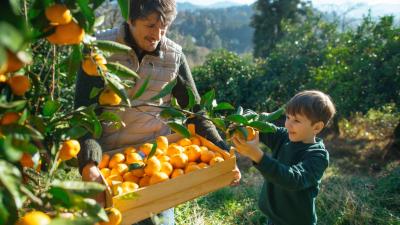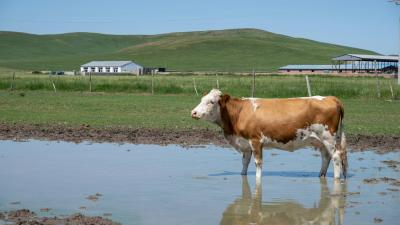Nutrition Scientists Name Top Five Eco-Friendly Food Swaps After NOAA Declares 2021 a Record Year for Methane, a Leading Greenhouse Gas

WASHINGTON, D.C— Nutrition scientists with the Physicians Committee for Responsible Medicine have named low-methane food alternatives that are healthier for humans and the planet than the five leading methane-emitting foods. The listicle comes just as the National Oceanic and Atmospheric Administration (NOAA) reports that it observed in 2021 a record increase in atmospheric levels of methane, a powerful, heat-trapping greenhouse gas. Methane is a greenhouse gas that contributes to climate change, second only to carbon dioxide.
“While methane contributes significantly to global warming, the good news is that it is relatively short-lived, meaning that it remains in the atmosphere for a shorter time compared with carbon dioxide,” explains Anna Herby, DHSc, RD, CDCES, nutrition education program manager for Physicians Committee. “During this short time in the atmosphere, however, it makes a significant impact on warming because it’s more efficient at trapping heat than carbon dioxide.”
Methane is a byproduct of fermentation. In the food and agriculture world, this means it mostly comes from ruminants, or grazing animals, and other animals in concentrated farmed environments, aka factory farms. When animals, and even fish, are kept in high numbers and close quarters, their waste concentrates and causes a release of methane.
“As it turns out, high-methane-emitting animal products tend to be the worst for our health as well,” Herby adds. Here are the Top Five Eco-Friendly Food Swaps, a list of the top methane-emitting foods and low-methane alternatives that are healthier for humans and the planet.
- Hamburgers: When it comes to food, beef is the highest greenhouse gas emitter, and half of that is methane. Red meat, like beef, is associated with heart disease, diabetes, and certain types of cancer.
Bean Burgers: A bean burger is a great replacement for a hamburger. Beans emit no methane gas in their production. Beans are low in fat, free of cholesterol, and are known to balance blood sugar and reduce cholesterol. - Dairy Products: Because cows produce so much methane through their digestion, dairy farms can be a significant problem for greenhouse gas emissions. Dairy products like milk and cheese are the number one source of saturated fat in the American diet. Saturated fat and cholesterol from dairy can contribute to heart disease, and milk and cheese are also linked with prostate, breast, and ovarian cancers.
Oat Milk: Oat milk is a delicious creamy alternative that’s growing in popularity. It doesn’t have any of the same health concerns as dairy milk and can be used on cereals, in coffee, or in cooking. The process of growing oats is sustainable and doesn’t emit any methane. - Prawns and Fish: Farmed prawns and fish cause methane release and are generally unsanitary when kept in these conditions. They can also impact the environment through damage to coastal mangrove swamps. Fish and shellfish accumulate toxins including mercury, polychlorinated biphenyls (PCBs), chlordane, dioxins, and dichlorodiphenyltrichloroethane (DDT), that can be harmful to the body.
Seaweed: Because seaweed is at the bottom of the food chain, it’s relatively free of the toxins accumulated in other seafood. A seaweed salad or vegetarian sushi can be a great way to satisfy a seafood craving and will also be a good source of iodine. - Pork: Concentrated pig farms are a source of methane due to the pigs’ waste breaking down in slurries and liquids. Pork is commonly eaten as a processed meat like sausage or bacon, foods classified as carcinogenic to humans by the World Health Organization.
Tempeh: Tempeh bacon is a smoky and healthy alternative to pork bacon. Tempeh is made from whole, fermented soybeans. In contrast to traditional bacon, tempeh bacon (soy) is actually associated with a reduced risk of certain cancers, especially breast cancer. - Lamb and Goat: Just like cows, these grazing animals release methane in the process of digesting food. Since lamb and goat are red meats, they carry similar risks to beef. When heated to high temperatures, the meat can form heterocyclic amines (HCAs) and polycyclic aromatic hydrocarbons (PAHs) which may lead to cancer.
Seitan: Seitan is a minimally processed food made from concentrated gluten. It’s a meaty alternative that takes on the flavor of the spices around it. Try seitan in a teriyaki bowl with vegetables and brown rice.
“Methane emissions are a significant part of the climate crisis,” Herby concludes. “By reducing intake of high-methane-emitting foods, we can reduce overall methane emissions and make an immediate improvement in the short-term consequences of climate change.”
Media Contact
Leslie Raabe
202-527-7319
lraabe[at]pcrm.org
Founded in 1985, the Physicians Committee for Responsible Medicine is a nonprofit organization that promotes preventive medicine, conducts clinical research, and encourages higher standards for ethics and effectiveness in education and research.








